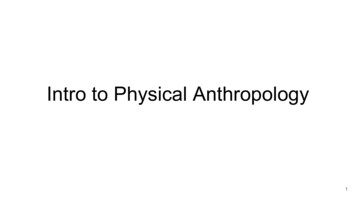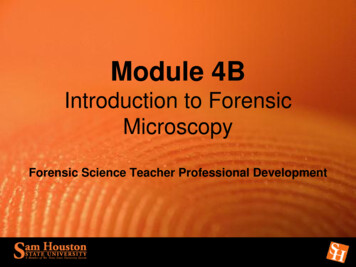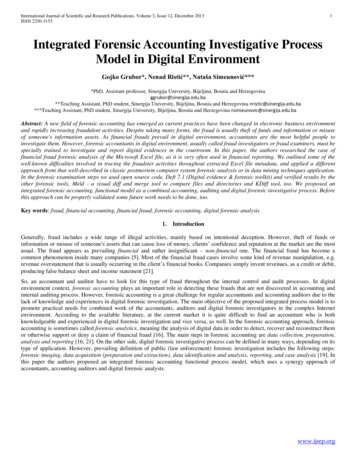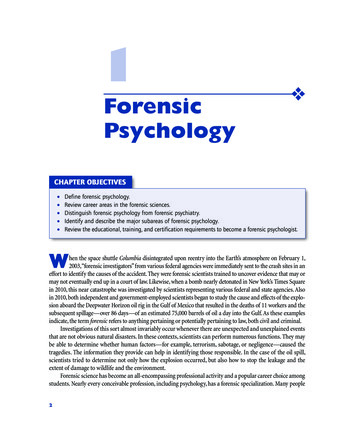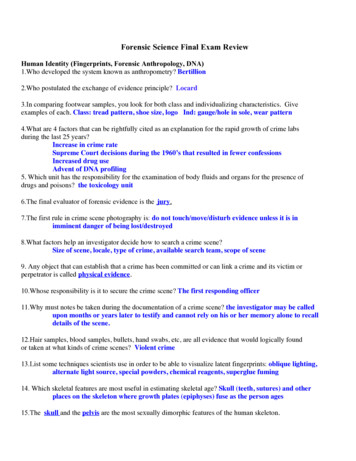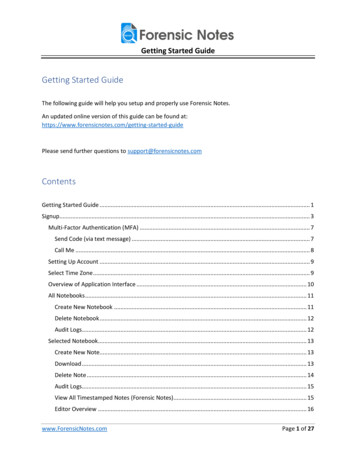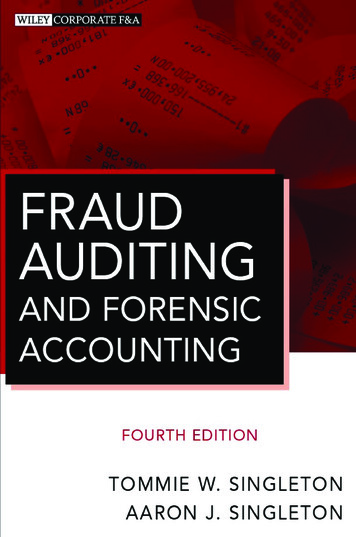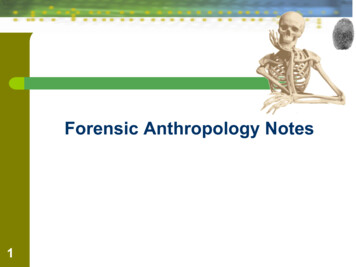
Transcription
Forensic Anthropology Notes1
Chapter 13 Forensic Anthropology:What We Learn from Bones describe how bone is formed distinguish between male and female skeletalremains explain how bones contain a record of injuries anddisease describe how a person’s approximate age could bedetermined discuss the role of mitochondrial DNA in boneidentificationAll Rights Reserved South-Western / Cengage Learning 20092Forensic Science: Fundamentals & Investigations, Chapter 13
Historical Development1.2.3.4.3In the 1800s, scientists began studying skulls.This laid the framework for today’s knowledge.In 1932 the FBI opened the first crime lab.The Smithsonian Institution became its workingpartner in the identification of human remains.Soldiers killed in World War II were identifiedusing anthropologic techniques.Forensic Science: Fundamentals & Investigations, Chapter 13
Development of Bone4 Bones originate from cells called osteoblasts. They migrate to the center of a cartilage bone“model” and deposit minerals- ossification. Throughout life, bones are being brokendown, deposited, and replaced- remodeling. Osteoclasts, the 2nd type of bone cell, amongother tasks, remove cellular wastes and breakdown old bone.Forensic Science: Fundamentals & Investigations, Chapter 13
5Forensic Science: Fundamentals & Investigations, Chapter 13
Bone development6Forensic Science: Fundamentals & Investigations, Chapter 13
How Bones ConnectBones are held together by:a. cartilage—wraps the ends of bones andkeeps them from scraping one another.b. ligaments—bands that connect two ormore bones together.c. tendons—connect muscle to bone. Until about 30 years of age, bones increase insize. Deterioration after 30 can be slowed withexercise. 7Forensic Science: Fundamentals & Investigations, Chapter 13
What role do anthropologists play in solvingcrimes?Watch the video and then answer the questions.1. What does a physical anthropologist investigate?2. What four things do we want to know about a skeleton?3. What bones are most useful for developing a profile of a person? Explainhow they are used.
Main Characteristics: Sex - Determined by examiningthe skull, pelvis, humerus, andfemur Age and stature (height/build) –Determined by analyzing thedevelopment of the teeth, bonegrowth, cranial suture lines, and thelength of specific bones, such asthe femur.Which skull would belong to a female? Race – Determined by analyzingthe skull for characteristics that arecommon among people of differentraces.Which pelvis would belong to a female?
Is it bone? 10The first thing the examining anthropologist mustdetermine is whether or not the material is bone.A surprising number of other materials may bemistaken for bone on first glance, especially ifthey are covered with dirt or other substances.To ensure the material is bone, theanthropologist cleans the object and examines itclosely, under magnification if necessary.Forensic Science: Fundamentals & Investigations, Chapter 13
Is it human? 11The next thing that a forensic anthropologistmight need to determine is whether or not thebone is human.All mammals share a generalized skeletaltemplate. However, the shape of the bonesand the way they relate to each other, differbetween animals. By examining the size,shape, and structure of a bone, ananthropologist can determine if it is human.Forensic Science: Fundamentals & Investigations, Chapter 13
Are remains modern or ancient? 12Anthropologists can often tell the differencebetween an ancient and modern skeleton by thecontext of deposition. (modern dental work,clothing, cell phone, etc)On the other hand, skeletal remains found inassociation with cultural objects consistent withlocal First Nations burial practices are likely to bethose of a person buried according to his or hercultural and social heritage and are therefore notof forensic interest.Forensic Science: Fundamentals & Investigations, Chapter 13
What Bones Can Tell Us 13Osteobiography tells much about a personthrough the study of the skeleton.The bones of a right-handed person, forexample, would be slightly larger than thebones of the left arm.Forensic scientists realize that bones contain arecord of the physical life.Analyzing bones can reveal clues to suchthings as gender, age, height, and health.Forensic Science: Fundamentals & Investigations, Chapter 13
GenderThe female skull is smoother than the male’sThe male frontal bone is lower and slopingThe male’s eye orbits are more circularMales have an occipital protuberance andlarge mastoid process Male jaw is more square and upright 14
Gender One of the easiest methods of determining thegender of a skeleton is by examining the pelvis. The surface of a woman’s pelvis can be scarred. The sub pubic angle of the female pelvis is greaterthan 90o; the male’s, less.15Forensic Science: Fundamentals & Investigations, Chapter 13
Gender Male have a narrow iliac crest Male have a sacrum that is tilted forward– Female sacrum is tilted back16Forensic Science: Fundamentals & Investigations, Chapter 13
Age 17The suture at the back of the skull (lamboidalsuture) begins closing at age 21, and by age 30will have closed.By about age 32, the suture running across thetop of the skull (sagittal suture), back to front,will have closed.By about age 50, the suture running side toside over the top of the skull, near the front(coronal suture), will have closed.Forensic Science: Fundamentals & Investigations, Chapter 13
18Forensic Science: Fundamentals & Investigations, Chapter 13
Age During life, many of the 450 bones a person hasat birth grow together, finally forming 206 bones. As the cartilage between them is replaced, anepiphysis line is visible. When the cartilage is fully replaced, the line is nolonger visible. This information can be used to approximate askeleton’s age.19Forensic Science: Fundamentals & Investigations, Chapter 13
Age20Teeth are the best way todetermine age in a childForensic Science: Fundamentals & Investigations, Chapter 13
Age for permanent teeth21Forensic Science: Fundamentals & Investigations, Chapter 13
Age22Forensic Science: Fundamentals & Investigations, Chapter 13
Height Just as age can be estimated by looking atthe bones of the arm and leg, so also can anestimate of height be made. Often, the approximate height of a personcan be calculated from one of the long boneseven if just one of those is found. Gender and race will need to be taken intoconsideration in making the estimate.23Forensic Science: Fundamentals & Investigations, Chapter 13
RaceRacial classifications in anthropology based oncranial and skeletal morphology:CaucasoidMongoloidNegroid24Forensic Science: Fundamentals & Investigations, Chapter 13
Skeletal Differences 25Nasal BonesShape of dental archShape of teethForm of the chinShape of skull and browForensic Science: Fundamentals & Investigations, Chapter 13
Facial Reconstruction A face is formed by the skull with the muscles and 26tissues on top of the skull.Theoretically, nonetheless, a face can be rebuiltfrom just skeletal remains.Facial markers are positioned at critical locationson a skull, and clay is contoured to follow theheight of the markers.Today, computer programs perform a similarfunction.These computer programs also can age missingpersons and criminals.https://facial reconstruction videoForensic Science: Fundamentals & Investigations, Chapter 13
What else can we learn from bones?DNA samples can be collected from bone, teeth, and hair toprovide clues to a person’s identity.Scientists may also be able to gain clues as to a person’s past,recent injuries, or the cause of death based on bone fracturesand other signs of trauma.Damage from ahammerHealed FracturesGunshot WoundsImages: ownload lo res.html?id aviclefx.jpg,
DNA Evidence Bone contains little nuclear DNA. But it does contain mitochondrial DNA. This has DNA that is inherited only from themother. Long after nuclear DNA has been lost throughtissue degeneration, mitochondrial DNA can beobtained from bone. Results can be compared with living relatives onthe mother’s side of the family to identify skeletalbones of Richard IIIremains.28Forensic Science: Fundamentals & Investigations, Chapter 13
Skeletal Trauma Analysis Forensic anthropologists often determine ifdamage to bones occurred before or afterdeath. Definite distinctions exist between patterns onbones made by weapons and the patternscreated by the environment after death. Sharp-force trauma, blunt-force trauma,gunshot wounds, and knife wounds all havedistinctive patterns.29Forensic Science: Fundamentals & Investigations, Chapter 13
Determining Cause of Death Sharp force trauma: bone cut Blunt force trauma: broken bone
Antemortem vs. Postmortem 31Antemortem – before death, should showsigns of healingPostmortem – after death, does not showsigns of healingPerimortem – occurred very close to time ofdeathForensic Science: Fundamentals & Investigations, Chapter 13
. . . . . . . . . . Summary . . . . . . . . Bones are live and carry on all life functions. The condition of bones can tell investigatorsabout a person’s health and nutrition duringlife. Male and female skeletons differ in many ways. The age of a person at death can be estimatedby analysis of a number of bones.32Forensic Science: Fundamentals & Investigations, Chapter 13
. . . . . . . . . . . . . . . . . Summary A person’s height can be estimated by thelength of long bones. Facial reconstruction is possible to someextent. Mitochondrial DNA can be extracted to helpidentify skeletal remains. Skeletal trauma analysis examines bones forevidence of damage.33Forensic Science: Fundamentals & Investigations, Chapter 13
4 Forensic Science: Fundamentals & Investigations, Chapter 13 Development of Bone Bones originate from cells called osteoblasts. They migrate to the center of a cartilage bone “model” and deposit minerals- ossification. Throughout life, bones are being broken down, deposited, and replaced-




